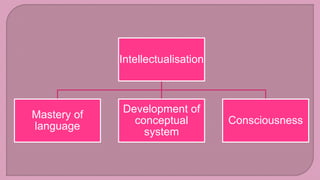F2 Heidy Rincon fslal_4_ UNAD
- 2. (Orsha, 1896 - Moscow, 1934) Lev Semyonovich Vygotsky was a Russian psychologist and one of the most prominent theorists of developmental psychology, he was also the founder of historical- cultural psychology and a clear precursor of Soviet neuropsychology, of which Maximum exponent is the Russian doctor Alexander Luria.
- 3. ?He had Marxist ideals (society without class distinction) ?From his work derives social or realistic constructivism ?It considers that development depends on learning and occurs through social processes. ?Presents social and cultural contexts as a fundamental part in the appropriation of knowledge ?For Vygotsky mental functions are social and classifications in two categories: lower and higher
- 4. ? Highlights the role of the social and collective part in development, ignoring the role of the individual ? Vygotsky talks about situated learning that refers to the fact that the individual primarily depends on other examples: A baby cries for hunger, pain, etc. It does so as a lower mental function, but when that same baby later cries he does so with the intention In this way, this is what makes Vygotsky call superior mental function, that is to say that it becomes an intrapsychological ability. ? When beginning to internalize the knowledge, the individual is becoming more autonomous in his action and enters the category interpsychological
- 5. ?In the theory of situated learning, human beings need a social part that encourages learning. ?For Vygotsky the collective is more important because each member brings something to the group, transforming it and strengthening it ?Through learning located the student learns according to their level of development, but for others it may require the help of the teacher or another more skilled partner
- 8. ? Issue: In a school in Bogot¨¢, a student has a cognitive difficulty, which affects her short-term memory. Susana is a 10-year-old girl, she is in the fourth grade of primary school; she has a low average in the English area, she has difficulty making simple sentences and has a poor vocabulary ? The objective: Include the constructivist theory of situated learning in order to improve the process of language acquisition in Susana and other students with difficulties in their memory process
- 9. Susana's teacher talks with the parents to involve them in the strategy (situated learning) that will be implemented at home and will be accompanied from the school, in order to allow Susana to acquire a greater vocabulary; for which they are explained the role they will play (active role). The strategy consists of: 1. Paste words in English in the different objects of the house (appliances, furniture, food, kitchen, bathroom, rooms, among others). 2. Every time Susana needs something she must say the name of the object in English. 3. In class the teacher will review with Susana and the other students vocabulary of the home. 4. Practice with colleagues the correct pronunciation of that vocabulary.
- 11. ? Biograf¨ªas y Vidas. (2004-2019). Biograf¨ªas y Vidas. Recuperado el 05 de 03 de 2019, de https://www.biografiasyvidas.com/biografia/v/vigotski.htm ? Gardey, J. P. (2009). Definicion.de. Recuperado el 06 de 03 de 2019, de https://definicion.de ? Oliva, U. Q. (s.f.). Sities Google. Recuperado el 05 de 03 de 2019, de Teor¨ªa Cosntructivista: https://sites.google.com/site/teoriaconstructivistau123/proceso /actividad-4











